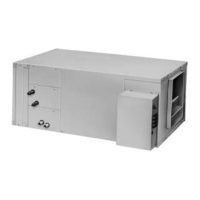32 BCXC-SVX01A-EN
Operation
Sequence of
Operation
Tracer ZN Controller Sequence
of Operation
Power-Up Sequence
When 24 VAC power is initially applied to
the Tracer
®
ZN controller, the following
sequence occurs:
• all outputs are controlled off
• Tracer
reads all input values to
determine initial values,
• the random start time (0-25 seconds)
expires, and
• normal operation begins.
Tracer ZN Modes of Operation
Tracer ZN controllers operate the fan in
one of the modes listed below as noted:
• occupied
• unoccupied
• occupied standby (Tracer ZN510 or
ZN520 only)
• occupied bypass
• Tracer Summit with supply fan control
(Tracer ZN510 or ZN520 only)
Note: The Tracer ZN520 controller
operates the supply fan continuously
when the controller is in the occupied
and occupied standby modes, for either
heating or cooling. The controller only
cycles the fan off with heating and
cooling capacity in the unoccupied mode.
When the communicated occupancy
request is unoccupied, the occupancy
binary input (if present) does not affect
the controller’s occupancy. When the
communicated occupancy request is
occupied, the controller uses the local
occupancy binary input to switch be-
tween the occupied and occupied
standby modes.
Occupancy Sources
There are four ways to control the Tracer
ZN controller’s occupancy, as noted
below:
1. By pressing the zone sensor’s timed
override “on” button
2. Occupancy binary input, either
normally open or normally closed, see
Table O-SO-1 for occupancy sensor
states
3. Default operation of the controller
(occupied mode)
4. Communicated request, usually
provided by the building automation
system (BAS) or peer device (available
on Tracer ZN510 and ZN520 only)
A communicated request will control the
controller’s occupancy. Typically, this
request comes from the BAS time-of-day
scheduling to the controller. However, if a
communication request from a BAS or
peer controller is lost, the controller
reverts to the default operating mode
(occupied) after 15 minutes (configurable,
specified by the “receive heartbeat
time”), if no local hardwired occupancy
signal exists.
If the unit is communicating with Tracer
Summit and the supply fan control
programming point is configured for
Tracer (the factory configures as local),
then Tracer Summit will control the fan
regardless of the fan mode switch
position.
For complete information about Tracer
Summit
application setup using the
Tracer ZN controller, see the Tracer
Summit product literature. For more
information on the setup of another BAS,
refer to the product-specific literature
from that manufacturer.
Occupied Mode
When the controller is in the occupied
mode, the unit attempts to maintain the
space temperature at the active occupied
heating or cooling setpoint, based on the:
• measured space temperature,
• the discharge air temperature (Tracer
ZN520 only),
• the active setpoint, and
• the proportional/integral control
algorithm.
The modulating control algorithm used
when occupied or in occupied standby is
described in the following sections.
Additional information related to the
handling of the controller setpoints can be
found in the previous setpoint operation
section.
Note: Heating and cooling setpoint high
and low limits are always applied to the
occupied and occupied standby
setpoints.
Unoccupied Mode
When the controller is in the unoccupied
mode, the controller attempts to
maintain space temperature at the
stored unoccupied heating or cooling
setpoint based on the:
• measured space temperature,
• active setpoint , and
• control algorithm, regardless of the
presence of a hardwired or
communicated setpoint.
Similar to other controller configuration
properties, the locally stored unoccupied
setpoints can be modified using Rover™
service tool.
During cooling mode, when the space
temperature is above the cool setpoint,
the primary cooling capacity operates at
100%. If more capacity is needed, the
supplementary cooling capacity turns on
(or opens to 100%).
During heating mode, when the space
temperature is below the heat setpoint,
the primary heating capacity turns on. All
capacity turns off when the space
temperature is between the unoccupied
cooling and heating setpoints. Note that
primary heating or cooling capacity is
defined by the unit type and whether
heating or cooling is enabled or disabled.
For example, if the economizer is
enabled (Tracer ZN520 only) and
possible, it is the primary cooling capac-
ity. If hydronic heating is possible, it will
be the primary heating capacity.
Occupied Standby Mode (Tracer ZN510
or ZN520 only)
The controller can be placed into the
occupied standby mode when a
communicated occupancy request is
combined with the local (hardwired)
occupancy binary input signal.
During occupied standby mode, the
Tracer ZN520 controller’s economizer
damper position goes to the economizer
standby minimum position.
Note: The economizer standby minimum
position can be changed using Rover
service tool.
Table O-SO-1. Occupancy Sensor State Table
Sensor Type Sensor Position Unit Occupancy Mode
Normally Open Open Occupied
Normally Open Closed Unoccupied
Normally Closed Open Unoccupied
Normally Closed Closed Occupied

